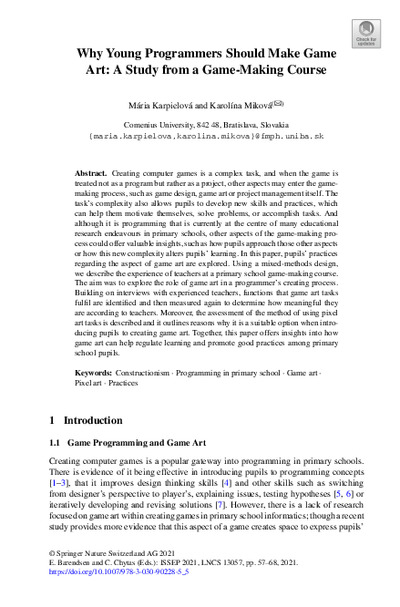Why Young Programmers Should Make Game Art A Study from a Game-Making Course
Mária Karpielová, Karolína Miková
|
 |
 Diese Seite wurde seit 2 Jahren inhaltlich nicht mehr aktualisiert.
Unter Umständen ist sie nicht mehr aktuell.
Diese Seite wurde seit 2 Jahren inhaltlich nicht mehr aktualisiert.
Unter Umständen ist sie nicht mehr aktuell.
 Zusammenfassungen
Zusammenfassungen
 Creating computer games is a complex task, and when the game is treated not as a program but rather as a project, other aspects may enter the game-making process, such as game design, game art or project management itself. The task’s complexity also allows pupils to develop new skills and practices, which can help them motivate themselves, solve problems, or accomplish tasks. And although it is programming that is currently at the centre of many educational research endeavours in primary schools, other aspects of the game-making process could offer valuable insights, such as how pupils approach those other aspects or how this new complexity alters pupils’ learning. In this paper, pupils’ practices regarding the aspect of game art are explored. Using a mixed-methods design, we describe the experience of teachers at a primary school game-making course. The aim was to explore the role of game art in a programmer’s creating process. Building on interviews with experienced teachers, functions that game art tasks fulfil are identified and then measured again to determine how meaningful they are according to teachers. Moreover, the assessment of the method of using pixel art tasks is described and it outlines reasons why it is a suitable option when introducing pupils to creating game art. Together, this paper offers insights into how game art can help regulate learning and promote good practices among primary school pupils.
Creating computer games is a complex task, and when the game is treated not as a program but rather as a project, other aspects may enter the game-making process, such as game design, game art or project management itself. The task’s complexity also allows pupils to develop new skills and practices, which can help them motivate themselves, solve problems, or accomplish tasks. And although it is programming that is currently at the centre of many educational research endeavours in primary schools, other aspects of the game-making process could offer valuable insights, such as how pupils approach those other aspects or how this new complexity alters pupils’ learning. In this paper, pupils’ practices regarding the aspect of game art are explored. Using a mixed-methods design, we describe the experience of teachers at a primary school game-making course. The aim was to explore the role of game art in a programmer’s creating process. Building on interviews with experienced teachers, functions that game art tasks fulfil are identified and then measured again to determine how meaningful they are according to teachers. Moreover, the assessment of the method of using pixel art tasks is described and it outlines reasons why it is a suitable option when introducing pupils to creating game art. Together, this paper offers insights into how game art can help regulate learning and promote good practices among primary school pupils. Dieser wissenschaftliche Zeitschriftenartikel erwähnt ...
Dieser wissenschaftliche Zeitschriftenartikel erwähnt ...
 Personen KB IB clear | Edith Ackermann , Idit Harel , Seymour Papert | |||||||||||||||||||||||||||
 Begriffe KB IB clear |  Computerspiele Computerspiele computer game
, computer game
,  design thinking
, design thinking
,  Lernen Lernen learning
, learning
,  Primarschule (1-6) / Grundschule (1-4) Primarschule (1-6) / Grundschule (1-4) primary school
, primary school
,  Programmieren Programmieren programming
, programming
,  Projektmanagement Projektmanagement project management project management
| |||||||||||||||||||||||||||
 Bücher |
| |||||||||||||||||||||||||||
 Texte |
|
 Dieser wissenschaftliche Zeitschriftenartikel erwähnt vermutlich nicht ...
Dieser wissenschaftliche Zeitschriftenartikel erwähnt vermutlich nicht ... 
 Nicht erwähnte Begriffe | LehrerIn, Schule, Unterricht |
 Zitationsgraph
Zitationsgraph
 Zitationsgraph (Beta-Test mit vis.js)
Zitationsgraph (Beta-Test mit vis.js)
 Anderswo finden
Anderswo finden
 Volltext dieses Dokuments
Volltext dieses Dokuments
 |  Why Young Programmers Should Make Game Art: A Study from a Game-Making Course: Artikel als Volltext @ Springer ( Why Young Programmers Should Make Game Art: A Study from a Game-Making Course: Artikel als Volltext @ Springer ( : :  , 577 kByte; , 577 kByte;  : :  ) ) |
 Anderswo suchen
Anderswo suchen 
 Beat und dieser wissenschaftliche Zeitschriftenartikel
Beat und dieser wissenschaftliche Zeitschriftenartikel
Beat hat Dieser wissenschaftliche Zeitschriftenartikel während seiner Zeit am Institut für Medien und Schule (IMS) ins Biblionetz aufgenommen. Beat besitzt kein physisches, aber ein digitales Exemplar. Eine digitale Version ist auf dem Internet verfügbar (s.o.). Aufgrund der wenigen Einträge im Biblionetz scheint er es nicht wirklich gelesen zu haben. Es gibt bisher auch nur wenige Objekte im Biblionetz, die dieses Werk zitieren.












 Biblionetz-History
Biblionetz-History